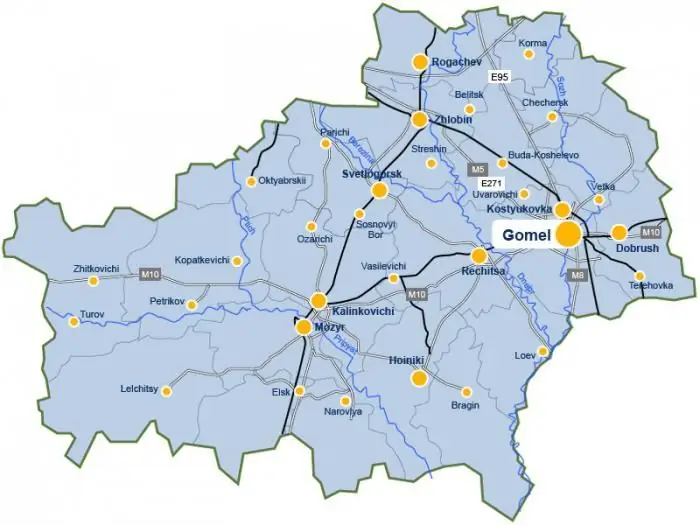- Author Harold Hamphrey [email protected].
- Public 2023-12-17 10:06.
- Last modified 2025-01-24 11:10.
Luga district is a territory in the south of the Leningrad region. The formation of the district took place in 1927. Previously, this area was called the county, it has functioned since 1781. The center is located in the city of Luga.
Territory and climatic conditions
Luga district of the Leningrad region occupies 6070 square meters. km. This is about 8% of the territory of the entire region. In the entire region, the point was ranked fifth in size. In the north is the Gatchina region, in the south - the border with the Pskov region. To get to the Luzhsky district, you need to drive 140 kilometers from St. Petersburg.

As for natural conditions, plains prevail here. Altitude range - from 0 to 100 meters above sea level. Glass sand and peat are mined here on an industrial scale.
Luga region of the Leningrad region is located in the temperate continental climate zone. The average temperature here ranges from +17 degrees in June to minus 8 degrees in January. No more than 700 mm of precipitation falls annually.
State of Nature
Luga Municipal District is crossed by the Luga River and its tributaries. You can find a large number of small lakes. There are also many swamps. The soils on whichstands Luga region, can be described as podzolic. To the west, you can walk through the pine forest. In the north there are plantations of birch and aspen. In the south and east, you can find land set aside for agricultural activities.
The Luga region also has a rich fauna. Here you can see foxes, big moose, hares, wolves, wild boars, roe deer. The bird family is represented by black grouse, duck, hazel grouse and capercaillie.
Some sites in the Luga region are protected in a special regime. For example, Mshinsky swamp and White stone. Work is underway to take care of the Glebov bog, the Syabersky and Cheremenetsky reserves.
Geological monument of nature are outcrops that illustrate the Devonian and Ordovician rocks. There are several more important local attractions of educational and historical significance. You can get here to the Zhelezo station, which belongs to the Pedagogical University. Students and teachers of biology and geography conduct practical and research work there.

History
The villages of the Luga region took shape as collective farms in 1927. This included 53 village councils, formerly uyezd subdivisions. Two more administrative units moved here from the Troitsky district. In 1928, consolidation took place, 22 village councils were abolished.
1930 was marked by the fact that the district became an integral part of the region. Until 1939, some more administrative changes took place, during which partsthen added, then moved away from the main territory. During the Great Patriotic War, the area was occupied, and significant damage was done to these places.
The district has undergone a number of changes, during which its boundaries, management system and structure have changed.

Population
As for the demographic situation, there are a lot more people here in the summer due to the fact that many tourists come from St. Petersburg. Many people love to visit Mshinskaya. This is a beautiful area set aside for gardening. If we look at recent trends, the population is naturally gradually decreasing due to urbanization. Slightly more than half of the region's population lives in settlements where urban conditions have been created. The majority of citizens by nationality are Russians.
Management
The functions of representative power are implemented by the Council of Deputies. Each settlement sends two people to the legislature. This is, as a rule, the head of the local administration, as well as an ordinary deputy who was nominated at the council of governors. The district authorities are represented by the head of its administration.
Starting from 2006, this position has been occupied by Valery Vasiliev. There are commissions on a permanent basis that deal with interaction with local organizations involved in construction and land development. These are non-budgetary bodies that control the construction of housing, the operation of communal complexes, the agro-industrial sector, the use of forests, the expenditure of budgetary funds, taxes and finances, entrepreneurialactivities, energy, vehicles, communication systems and tourism. Special attention is paid to he alth protection, provision of pensioners, culture, sports and law enforcement.

Other powers
As for the executive branch, its powers are given to the administration, the head of which is a candidate elected by a special commission. Since 2006, this position has been held by Sergey Timofeev, who is supported by three deputies. They are engaged in archives, inspection of the SASN, juvenile affairs, control of the work of the municipal election commission, general office work, architecture and construction work, accounting, supervision of the actions of the registry office, the information sphere, politics, culture and sports, and the educational sphere.
In addition, they control and organize work on interaction with individual settlements, coordinate the actions of the agricultural and industrial complexes, and the movement of municipal property. Also, their competence includes the management of communications and transport, the development of the economy, jurisprudence, the financial industry and the protection of the population in social terms.

Industrial enterprises include an abrasive plant, enterprises producing reinforced concrete, metal structures, mixed fodder, glass, dairy products, meat, padding polyester, pillows. This is a fairly developed, self-sufficient and independent area.






